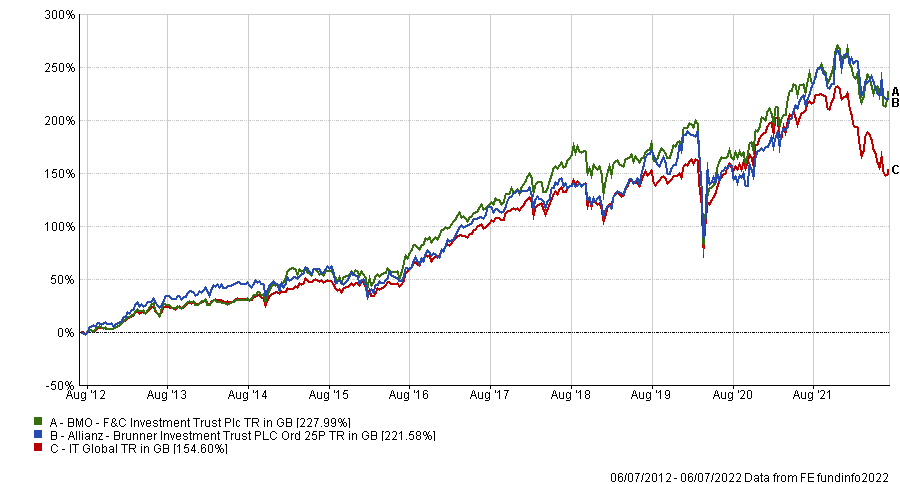Finding a portfolio that can make top returns while limiting the downside has likely been the aim of many investors over the past year as markets have proven exceptionally choppy.
While it has been a tough ask, global portfolios F&C and Brunner have achieved top returns while seemingly keeping volatility under control.
As global equities have been affected by macroeconomic concerns, which have in turn led to investors’ fears of a recession, both F&C and Brunner managed to detach themselves from their peers and stem their losses, while the rest of the IT global sector plummeted in a downward spiral.
Indeed, over the past year, the two trusts contained the damage at single digits against a 20% fall for the sector average, as illustrated below.
Performance of the trusts over 1yr vs the sector

Source: FE Analytics
The trusts outperformed their sector over the long term as well, distancing themselves from their counterparts by a good 70 percentage points, as the chart below shows.
Both trusts are members of the AIC’s Dividend Hero selection with F&C having a 51-year track record compared to Brunner’s 50.
One might be tempted to see a shared success story, but there is no common denominator to their performances, according to experts. In fact, the two trusts employ very different investment approaches, which have delivered outstanding results in their own individual ways.
Each of the two strategies, outlined below, proved effective for different reasons, which might make it even more difficult for investors to decide which one is the better option for them and if one is better than the other.
Performance of the trusts over 10yrs vs the sector

Source: FE Analytics
Differences
Starting with F&C, the trust was established in 1868 and owns the title of the oldest investment trust in the world. From this fact alone, it attracts the attention of a wide array of investors, said Emma Bird, research analyst at Winterflood.
It is particularly popular among those in search of broad stock market exposure, as its manager, Paul Niven, together with an “experienced and well-resourced” team, has assembled a highly diversified multi-manager portfolio of more than 450 holdings, spanning all major equity regions.
One of the trust’s biggest differentiators is its sizable 10% invested in private equity, which outperformed listed peers last year.
David Johnson, investment trust analyst at Kepler Partners, noted that Niven’s large allocation to private equity funds “reflects the advantages of the closed-ended structure, adding both diversification and alpha potential”.
While F&C is a potential ‘one-stop shop’ solution for an investor seeking broad equity exposure, Brunner is not a multi-manager portfolio, focusing instead on individual companies and placing the greatest weight on the ‘quality’ factor.
Given the emphasis on focused stock selection, it is unsurprising that Brunner’s portfolio comprises 65 stocks, compared to F&C’s 400.
Matthew Tillett’s strong focus on valuation also sets the trust apart from some of its global equity peers. This valuation discipline “has led Brunner to be one of the best performing strategies in its global equity peer group over 2022”, said Johnson.
Bird too was “impressed” with Tillett since he took responsibility of Brunner in Many 2020. To December of the following year, the fund had returned 46.9%, compared with 38.1% for the FTSE All Share and 40.5% for the FTSE All World index, according to data from Numis.
One more explanation for Brunner’s above-average returns could be its long-held overweight to the UK, at a time when UK equities were outperforming the global market. The trust had 25% in its home market at the end of May, while F&C’s exposure stood at 10%.
Looking at geographical distributions, there is even more disparity, as Brunner’s portfolio concentrates on developed markets, whilst F&C has direct exposure to emerging markets, which comes with different levels of risks and rewards.
Experts’ recommendations
Despite the common goal of income growth and the shared exposure to global equities, the two trusts have unique strategies that come with their pros and cons.
Of the two, Bird “would be minded to recommend F&C Investment Trust, recognising the advantages that come with its size and diversified portfolio.
“Furthermore, as and when sentiment towards equities improves, it could be a beneficiary, while renewed buying interest should lead to its discount narrowing,” she said.
F&C’s discount is currently at 11%, a long way from the board’s aspiration of trading close to NAV, while Brunner currently trades on a 8% discount – another factor to consider between the two, she said.
On the other hand, in Johnson’s view, it is not a case of ‘one or the other’. “In fact, both Brunner and F&C could easily sit beside each other in the same portfolio,” he said, suggesting investors may wish to allocate capital equally between the two.





